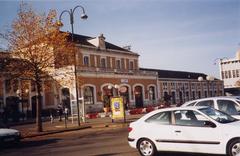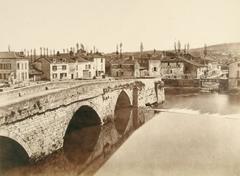
Visiting Guide to Église Saint-Étienne de la Cité in Périgueux
Publication Date: 01/08/2024
Introduction to Église Saint-Étienne de la Cité
Nestled in the heart of Périgueux, France, the Église Saint-Étienne de la Cité stands as a monumental testament to the rich tapestry of history and architectural evolution in the region. Originally, the site hosted a Roman temple dedicated to Mars, reflecting the ancient city’s importance as a Gallo-Roman settlement known as Civitas Petrucoriorum (Wikipedia). The first Christian structure emerged in the early 6th century, marking the beginning of a long ecclesiastical legacy under Bishop Chronope II. Over centuries, the church evolved architecturally, beginning with Romanesque designs in the 11th century which later incorporated elements of Gothic style (Guide du Périgord).
Originally serving as the primary cathedral of Périgueux, the church played a central role in the religious and cultural life of the area until the mid-17th century. However, the Wars of Religion in the 16th century brought significant destruction, leading to considerable structural changes (SeeDordogne). By the late 17th century, the ecclesiastical seat moved to the newly built Cathédrale Saint-Front, relegating Église Saint-Étienne to a parish church and even a riding school during the Fronde (Monumentum).
In the 20th century, significant restoration efforts led by architect Henri Rapine began, aiming to preserve its historical and architectural integrity (Wikipedia). Today, the church is a popular site for visitors, offering a glimpse into the region’s storied past and architectural grandeur, highlighted by its remarkable domes and the delicate blend of styles from different eras (Guide du Périgord).
Contents Overview
Visiting Église Saint-Étienne de la Cité: History, Tickets, and Tips
Historical Background
Early Beginnings and Roman Influence
The site of the Église Saint-Étienne de la Cité in Périgueux, France, has a rich history that dates back to the Roman era. Originally, this location was home to a Roman temple dedicated to the god Mars. The ancient city of Périgueux, known as Civitas Petrucoriorum, was a significant Gallo-Roman settlement. The first Christian structure on this site was erected in the early 6th century by Bishop Chronope II, marking the beginning of its long ecclesiastical history (Wikipedia).
Construction and Architectural Evolution
The construction of the current Romanesque church began in the 11th century and continued into the 12th century. Initially, the church featured a single nave with three square bays, a flat chevet, and two domes. Over time, it expanded to include four domes and a bell tower, showcasing the architectural style known as the ‘École du Périgord,’ characterized by its domed structures (Guide du Périgord).
Role as the First Cathedral
The Église Saint-Étienne de la Cité served as the primary cathedral of Périgueux until the mid-17th century. It was the central place of worship and ecclesiastical authority in the region. However, its prominence was challenged during the Wars of Religion in the 16th century. In 1577, Protestant forces attacked the church, destroying two of its domes and the bell tower. This period of conflict significantly altered the structure and function of the church (SeeDordogne).
Decline and Transformation
Following the damage inflicted during the Wars of Religion, the church underwent several transformations. In 1669, the episcopal seat was transferred to the newly constructed Cathédrale Saint-Front, relegating Saint-Étienne to the status of a parish church. During the Fronde, a series of civil wars in France, the church was further repurposed as a riding school, reflecting its diminished ecclesiastical role (Monumentum).
Restoration Efforts
The 20th century saw significant restoration efforts aimed at preserving the historical and architectural integrity of the Église Saint-Étienne de la Cité. In 1907, a major restoration campaign led by architect Henri Rapine began. This project included replacing the western nave’s tile roof with a stone covering, restoring the church closer to its original Romanesque style. These efforts were crucial in maintaining the church’s historical significance and architectural beauty (Wikipedia).
Architectural Highlights
The church’s architecture is a testament to its long and varied history. The western dome, dating back to the 11th century, remains a prime example of Romanesque art. In contrast, the eastern dome, restored in the 17th century, features Gothic arches, showcasing the blend of architectural styles that the church has undergone over the centuries. Inside, visitors can find an elegant broken arch above the tomb of Bishop Jean d’Asside and an 18th-century organ from Carrouges, which was restored in 1993 (Guide du Périgord).
Visitor Information
Visiting Hours and Tickets
The Église Saint-Étienne de la Cité is open to visitors from 9 am to 6 pm, except on Sundays. Admission is free, but donations are welcome to support ongoing maintenance and restoration efforts. For those interested in a more in-depth exploration, guided tours are available through the Périgueux Tourist Office.
Travel Tips
- Best Time to Visit: Spring and early autumn are ideal for visiting Périgueux, offering mild weather and fewer tourists.
- Photography Spots: The exterior façades and the interior domes provide excellent photo opportunities. Be mindful of other visitors and worshippers when taking photos.
- Accessibility: The church is partially accessible to visitors with mobility issues. Contact the Périgueux Tourist Office for detailed accessibility information.
Nearby Attractions
While visiting Église Saint-Étienne de la Cité, you can also explore other nearby historical sites in Périgueux:
- Musée Gallo-Romain Vesunna: A museum dedicated to the Gallo-Roman history of the region.
- Château Barrière: A medieval castle offering insights into the region’s feudal past.
Conclusion
The Église Saint-Étienne de la Cité stands as a monument to the rich and varied history of Périgueux. From its origins as a Roman temple site to its role as the first cathedral and its subsequent transformations, the church encapsulates the historical and architectural evolution of the region. Its preservation and restoration efforts ensure that future generations can continue to appreciate its historical and cultural significance. Visitors to Périgueux are encouraged to explore this remarkable site and immerse themselves in its fascinating history (Lonely Planet).
FAQ
Q: What are the visiting hours for Église Saint-Étienne de la Cité?
A: The church is open from 9 am to 6 pm, except on Sundays.
Q: Is there an admission fee for visiting Église Saint-Étienne de la Cité?
A: Admission is free, but donations are welcome.
Q: Are guided tours available?
A: Yes, guided tours are available through the Périgueux Tourist Office.
Q: Is the church accessible for visitors with mobility issues?
A: The church is partially accessible. For detailed information, contact the Périgueux Tourist Office.
Call to Action
Stay up to date with the latest news and events at Église Saint-Étienne de la Cité by following us on social media. Download the Périgueux Tourist Office mobile app for more travel tips and information on other historical sites in the region.
Source Citations
- Wikipedia. Église Saint-Étienne-de-la-Cité. Retrieved from Wikipedia.
- Guide du Périgord. Église Saint-Étienne de la Cité. Retrieved from Guide du Périgord.
- SeeDordogne. Église Saint-Étienne de la Cité, Périgueux. Retrieved from SeeDordogne.
- Monumentum. Église Saint-Étienne de la Cité. Retrieved from Monumentum.
- France This Way. Visiting Église Saint-Étienne de la Cité. Retrieved from France This Way.


